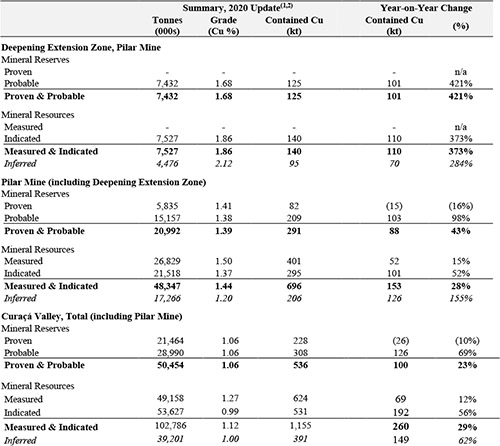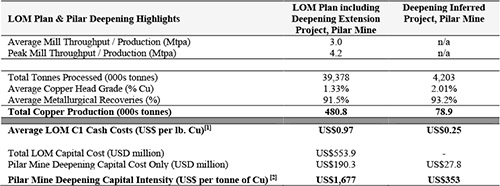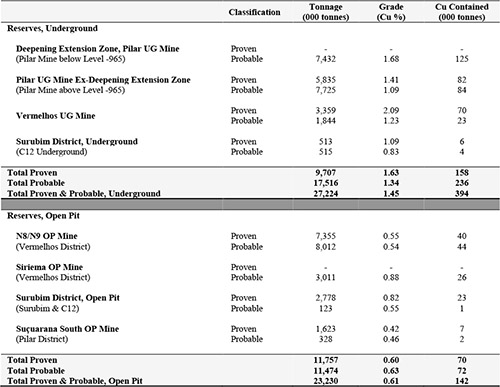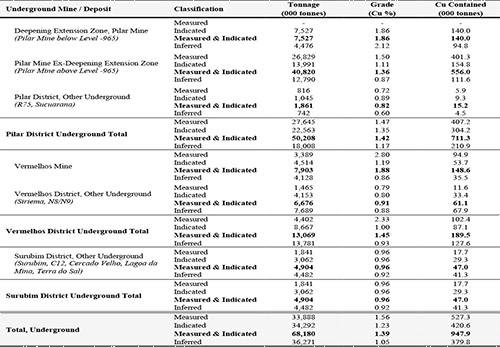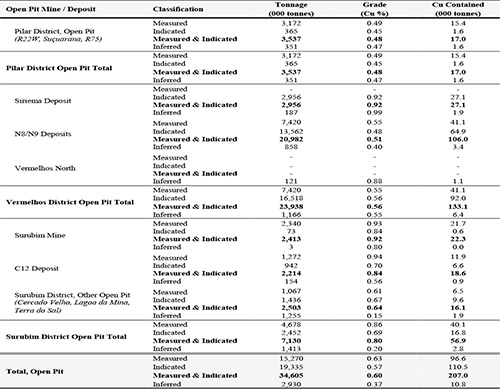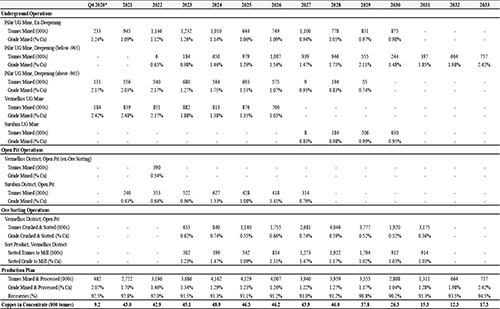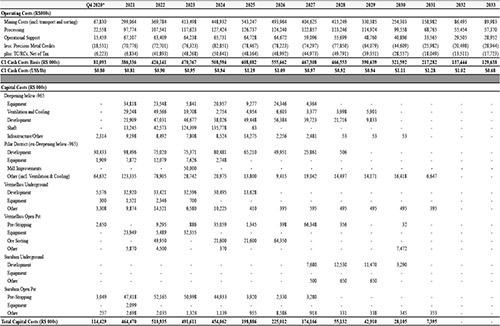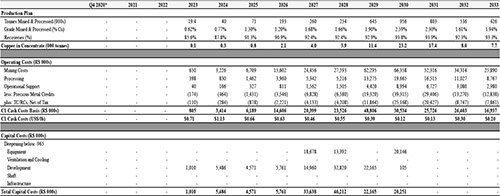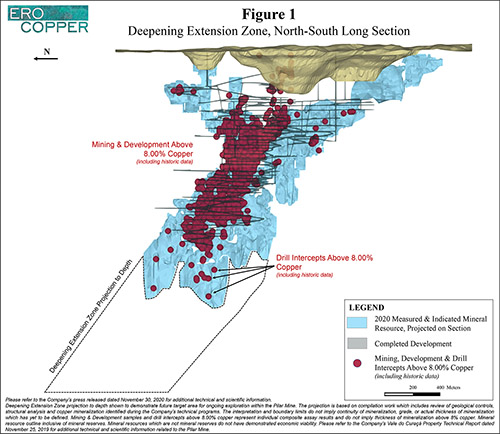Vancouver, British Columbia – Ero Copper Corp. (the “Company”) (TSX: ERO) is pleased to announce the release of its 2020 updated National Instrument 43-101 Standards of Disclosure for Mineral Projects (“NI 43-101”) compliant mineral reserve and resource estimate along with updated life of mine (“LOM”) production, capital and operating cost projections on its 99.6% owned Vale do Curaçá Property (herein referred to as the “Curaçá Valley”) located in Bahia State, Brazil.
Within the Curaçá Valley LOM production plan, for the 2020 update, the Company has included production, capital and operating cost projections based upon the mineral reserves derived from the Measured and Indicated mineral resources from within the Deepening Extension Zone of the Pilar Mine (the “Deepening Extension Project”). In addition, the Company has included an independent preliminary economic assessment based upon the Inferred mineral resources within the Deepening Extension Zone of the Pilar Mine (the “Deepening Inferred Project”), that shows the expected synergies associated with utilizing the infrastructure that will be built in support of the Deepening Extension Project, to illustrate the potential of the Deepening Extension Zone.
Highlights of the 2020 update include:
- Significant increase in contained copper within the mineral reserves and resources of the Pilar Mine with the inclusion of the Deepening Extension Zone. Proven and Probable mineral reserves, at the same long-term copper price assumption of US$2.75 per pound, increased by 43%, while Measured and Indicated, and Inferred Resources increased by 28% and 155%, respectively. The mineralized extent of the Deepening Extension Zone has yet to be fully defined and remains open to the north, east and to depth.
- Overall Curaçá Valley contained copper within the Proven and Probable mineral reserves, Measured and Indicated, and Inferred mineral resources increased by 23%, 29% and 62% respectively, inclusive of the Deepening Extension Zone.
- LOM copper production targeting average C1 cash costs at or below US$1.00 per pound of copper is shown in the table below. The LOM production plan includes ongoing production from the Vermelhos and Pilar mines (including the Deepening Extension Project), open pit production utilizing ore sorting from the N8/N9 and Siriema open pit operations within the Vermelhos District and non-ore sorted production from the Surubim District open pit operations of Surubim and C12:
- _________________________
1 Q4 2020 production outlines the mineral reserve schedule for the three months from the effective date of October 1, 2020 to December 31, 2020. Please refer to the detailed mineral reserve and mineral resource tables of this press release, as detailed in the “Mineral Reserves, 2020”, “Underground Mineral Resources, 2020”, and “Open Pit Mineral Resources, 2020” sections of this press release, as well as the “Technical and Scientific Information” below for additional information on the stated mineral reserves and mineral resources.
2 Presented mineral resources inclusive of mineral reserves. Mineral resources that are not mineral reserves do not have a demonstrated economic viability. All figures have been rounded to the relative accuracy of the estimates. Summed amounts may not add due to rounding.
- The Deepening Inferred Project is preliminary in nature and based on the Inferred mineral resources of the Deepening Extension Zone which are considered too speculative geologically to have the economic considerations applied to them that would enable them to be categorized as mineral reserves, and there is no certainty that the Deepening Inferred Project will be realized. Mineral resources that are not mineral reserves do not have a demonstrated economic viability. Please refer to the “Deepening Inferred Project” section of this press release for additional technical and scientific information related to the Deepening Inferred Project
- Integration of ore sorting into the Company’s LOM plan for the Vermelhos District open pit deposits of N8/N9 and Siriema contribute to improved mill head-grades and maintaining first-quartile C1 cash costs over the LOM.
- With the inclusion of the Deepening Extension Project at the Pilar Mine, a significant increase in production from the current 1.2 Mtpa ore mined to approximately 2.2 Mtpa ore mined is planned. The expansion of the Pilar is supported by the installation of a new external shaft, scheduled to commence construction in Q3 2021, that will not only support the planned increases in copper production at the Pilar Mine but has also been designed to support the potential for longer term copper production increases from both the Deepening Inferred Project and as additional mineralization is defined. In keeping with the Company’s return on invested capital focus, the expansion of the mine and development of the infrastructure in support of the Deepening Extension Project is being delivered at a low capital-intensity ratio of approximately US$1,677 per tonne of incremental copper production delivered over the LOM.
- Additional LOM Plan & Pilar Deepening Highlight Notes:
- C1 Cash Costs expressed in US Dollars (“USD”), converted at a USD to Brazilian Real (“BRL”) foreign exchange rate of 5.00, assumes gold and silver price of $1,750 and $18.00 per ounce, respectively. Fixed processing costs and operational support for the Curaçá Valley are allocated to the Company’s LOM Plan.
- Capital costs for capital intensity figures converted to USD at a USD:BRL foreign exchange rate of 5.00. Capital intensity figures based on recovered copper assuming average LOM metallurgical recovery, as disclosed in this table.
- The Deepening Inferred Project is preliminary in nature and based on the Inferred mineral resources of the Deepening Extension Zone which are considered too speculative geologically to have the economic considerations applied to them that would enable them to be categorized as mineral reserves, and there is no certainty that the Deepening Inferred Project will be realized. Mineral resources that are not mineral reserves do not have a demonstrated economic viability. Please refer to the “Deepening Inferred Project” section of this press release for additional technical and scientific information related to the Deepening Inferred Project.
Commenting on the update, David Strang, President and CEO stated, “Our 2020 updated mineral reserve and resource estimate and LOM plan reflects a considerable effort across our organization to deliver on several key initiatives that we commenced late last year. All of these initiatives were delivered under our corporate philosophy of maintaining a high return on invested capital for our shareholders and targeting LOM operating costs at or below US$1.00 per pound of copper.
First, and most significantly, this includes the delivery of the Deepening Extension Project at the Pilar Mine from initial concept in late 2019, through 12 months of aggressive drilling and extensive engineering and design work undertaken by our technical teams with the support of a large, diversified group of external consultants. While the Deepening Extension Project, technically, remains a mere extension of our existing operations at Pilar, the inclusion of the new shaft along with updated ventilation and cooling provides us with increased flexibility to not only increase overall production from Pilar but also improve the operating environment for our operations teams working in the mine, thereby increasing operating time at the working face.
Further, we believe the new shaft will support production from the deeper parts of the Pilar mine well beyond the currently defined mineral reserves within the Deepening Extension Project in this update. As we have stated, mineralization in the Deepening Extension Zone remains open to the north, to depth and to the east best evidenced by the high-grade Inferred mineral resources outlined in this update. These resources have been categorized as Inferred resources primarily as a result of variability in drill hole spacing due to the acute angles and limited availability of drill stations. During 2021, we will be developing exploration drives that we expect will enable holes to be drilled at angles that will allow for upgrading of these Inferred resources to the Measured and Indicated categories. These exploration drives will also assist in our ability to evaluate potential extensions to the current known limits of mineralization of the Deepening Extension Zone.
The second initiative reflected in our LOM update is the successful integration of ore-sorting into our operations following the completion of a comprehensive trial campaign earlier this year. The integration of ore-sorting within our operations will allow us to remove a significant amount of waste material mined, deliver feed to the plant at significantly higher copper grades and thereby lower transportation and processing costs while allowing our operations to use less water and power, and generate significantly less tailings. The integration of ore-sorting, like the Deepening Extension Project, is in-line with our corporate philosophy of maintaining high returns on invested capital, low capital intensity and first quartile operating costs.
With our updated LOM plan now in place, we have a solid production platform on which we can continue to grow. Relative to the mill’s original design capacity of 5.5 million tonnes per annum, our updated LOM plan retains excess capacity of up to 1.3 million tonnes per annum, which continues to provide flexibility to augment our near- to medium-term production profile with new discoveries. In 2021, we will be focusing our exploration efforts on defining new mineral resources and reserves within the Southern Vermelhos Corridor to extend the operational life at the Vermelhos Mine beyond 2026. We will also be focusing on upgrading the Inferred resources within the Deepening Extension Zone while continuing to define extensions of mineralization to the north, to depth and to the east as well as refocus some of our exploration efforts at Pilar on the West Limb to further define down plunge extensions. And of course, we will continue to advance our regional exploration programs in a post-Covid environment that will allow our geological team and consultants greater freedom to travel to site on a regular basis.”
The 2020 updated mineral reserve and resource estimate for the underground and open pit deposits and mines of the Curaçá Valley are shown in the tables below:
Mineral Reserves, 2020
Mineral Reserve Notes:
- Mineral reserve effective date of October 1, 2020. All figures have been rounded to the relative accuracy of the estimates. Summed amounts may not add due to rounding.
- Mineral reserve estimates were prepared in accordance with the Canadian Institute of Mining, Metallurgy and Petroleum (“CIM”) Definition Standards for Mineral Resources and Mineral Reserves, adopted by the CIM Council on May 10, 2014 (the “CIM Standards”), and the CIM Estimation of Mineral Resources and Mineral Reserves Best Practice Guidelines, adopted by CIM Council on November 23, 2003 (the “CIM Guidelines”), using geostatistical and/or classical methods, plus economic and mining parameters appropriate for the deposit. Mineral reserves are based on a long-term copper price of US$2.75 per pound (“lb”), and a USD:BRL foreign exchange rate of 4.27, except for the C12 (Surubim District) and Suçuarana (Pilar District) open pit mines, whose design was not changed in 2020, and continued to assume a 3.70 USD:BRL foreign exchange rate. Mineral reserves are the economic portion of the Measured and Indicated mineral resources. Mining dilution and recovery factors vary for specific mineral reserve sources and are influenced by factors such as deposit type, deposit shape, stope orientation and selected mining method. Inferred resource blocks, where unavoidably mined, were assigned zero grade. Dilution occurring from Measured & Indicated resource blocks was assigned grade based upon the mineral resource grade of the blocks included in the dilution envelope. Please see “Technical and Scientific Information” for additional information on the stated mineral reserves.
Underground Mineral Resources, 2020
Underground Mineral Resource Notes:
- Mineral resource effective date varies by deposit, with an effective date of August 8, 2020 except for P1P2 (July 24, 2020), R75 (July 9, 2019) and Suçuarana (July 3, 2020) within the Pilar District; Vermelhos Mine (July 29 2020), Siriema and N8 (July 4, 2020), N9 (July 9, 2019) within the Vermelhos District; and Surubim District effective date of July 9, 2019 except for Terra do Sal (July 3, 2020).
- Presented mineral resources inclusive of mineral reserves. All figures have been rounded to the relative accuracy of the estimates. Summed amounts may not add due to rounding.
- Mineral resources have been constrained within newly developed 3D lithology models applying a 0.45% and 0.20% copper grade envelope for high and marginal grade, respectively. Within these envelopes, mineral resources for underground deposits were constrained using varying stope dimensions of up to 20m by 10m by 35m applying a 0.51% copper cut-off grade, as well as a 0.32% copper marginal cut-off grade. Mineral resources have been estimated using ordinary kriging inside 5m by 5m by 5m block sizes. The mineral resource estimates were prepared in accordance with the CIM Standards, and the CIM Guidelines, using geostatistical and/or classical methods, plus economic and mining parameters appropriate to the deposit. Please see “Technical and Scientific Information” below for additional information on the stated mineral resources.
Open Pit Mineral Resources, 2020
Open Pit Mineral Resource Notes:
- Mineral resource effective date varies by deposit, with an effective date of August 8, 2020, except for Suçuarana (July 3, 2020), R22W and R75 (July 9, 2019) within the Pilar District; Siriema and N8 (July 4, 2020), N9 and Vermelhos North (July 9, 2019) within the Vermelhos District; and an effective date of July 9, 2019 for the Surubim District except Terra do Sal (July 3, 2020). Presented mineral resources inclusive of mineral reserves. All figures have been rounded to the relative accuracy of the estimates. Summed amounts may not add due to rounding.
- Mineral resources have been constrained within newly developed 3D lithology models using a 0.21% copper cut-off grade for open pit deposits. Mineral resources have been estimated using ordinary kriging inside 5m by 5m by 5m block sizes. The mineral resource estimates were prepared in accordance with the CIM Standards, and the CIM Guidelines, using geostatistical and/or classical methods, plus economic and mining parameters appropriate to the deposit. Please see “Technical and Scientific Information” below for additional information on the stated mineral resources.
Mineral resources which are not mineral reserves do not have demonstrated economic viability.
UPDATED LOM PRODUCTION PLAN, OPERATING & CAPITAL COSTS
The Company’s updated LOM production plan, based upon updated mineral reserves within the Curaçá Valley, is highlighted by the inclusion of the Deepening Extension Project and integration of ore sorting into the Company’s operations. Copper production over the updated LOM plan totals approximately 481,000 tonnes of copper in concentrate, at average C1 cash costs of $0.97 per lb. of copper produced.
The tables below outline the updated production plan for the Curaçá Valley, as well as associated capital and operating cost projections, which do not include estimates for the Deepening Inferred Project which can be found later in this press release. Amounts are presented in thousands of Brazilian Real (“BRL”). Where applicable, C1 cash costs, as defined by the Company are presented in US Dollars (“USD”) per pound of copper produced, based on a USD:BRL foreign exchange rate of 5.00, and by-product gold and silver prices of $1,750 and $18.00 per ounce, respectively.
LOM Production Plan
(*) Q4 2020 production outlines the mineral reserve schedule for the three months from the effective date of October 1, 2020 to December 31, 2020. All figures have been rounded to the relative accuracy of the estimates. Summed amounts may not add due to rounding. LOM plan operating and capital costs totals are based on mineral reserves and do not include the Deepening Inferred Project. See “Deepening Inferred Project” section of this press release for additional details.
LOM Plan Operating & Capital Costs (R$ 000s)
C1 Cash Cost & Capital Expenditure Notes:
- Presented C1 Cash Costs assumes USD:BRL FX rate of 5.00, gold price of US$1,750 per ounce and silver price of US$18.00 per ounce.
- C1 Cash Cost of copper produced is a non-IFRS measure, as more particularly discussed under the “Non-IFRS Measures” section of this press release.
- Capital expenditures shown do not include discretionary greenfield or brownfield exploration.
MINERAL RESOURCE GROWTH
The following section discusses the updated mineral reserve and resource estimates as they relate to the Pilar and Vermelhos Districts, and target areas for continued growth. Relative comparisons of 2020 to 2019, where applicable, refers to the 2020 updated mineral resource and reserve estimate discussed herein and the 2019 Technical Report, respectively. A more fulsome discussion of each of the deposits of the Curaçá Valley and the installed infrastructure within each of the mineral districts can be found in the 2019 Technical Report.
The mineral resources, planned development and exploration target areas within the Pilar and Vermelhos Districts outlined in this press release will be made available on the Company’s Curaçá Valley site tour and interactive three-dimensional models for the Pilar Mine and the Vermelhos System, which can be accessed via the Company’s website (www.erocopper.com) or via VRIFY Technology Inc. (“VRIFY”) (www.vrify.com).
Pilar District
The Pilar District encompasses the Pilar underground mine (which includes the zones of: Baraúna, the Deepening Extension Zone, East Limb, MSB South, the West Limb, P1P2N, R22 and P1P2W) as well as the open pit deposits of R75, and Suçuarana. In total, contained copper within the Measured and Indicated resource categories increased by approximately 166,000 tonnes of copper as compared to the 2019 Technical report, based on 30.8 million tonnes grading 1.37% copper of Measured mineral resources and 23.0 million tonnes grading 1.33% copper of Indicated mineral resources.
A major focus of the Company’s 2020 mineral resource and reserve update was to extend the known limits of the Pilar Mine at depth, targeting high-grade mineralization within the Deepening Extension Zone. During the period from September 2019 to August 2020, a total of 19,600 meters of drilling were completed in support of this objective. In total, contained copper within the Indicated mineral resource category of the Deepening Extension Zone increased by approximately 110,000 tonnes of copper (comprised of 7.5 million tonnes grading 1.86% copper vs. 1.4 million tonnes grading 2.19% copper as set out in the 2019 Technical Report). Additionally, approximately 70,000 tonnes of additional contained copper added within newly defined, high-grade, Inferred mineral resources of the Deepening Extension Zone totalling 4.5 million tonnes grading 2.12% copper, representing a 284% increase in contained copper at a 14% improvement in grade (compared to 1.3 million tonnes grading 1.86% copper as set out in the 2019 Technical Report). A drill program focused on upgrading portions of this new high-grade Inferred mineral resources within the Deepening Extension Zone is underway. Recent drilling in this area is highlighted by hole FC5367 that intercepted 29.9 meters grading 5.90% copper and FC5514 that intercepted 22.0 meters grading 2.14% copper including 9.0 meters grading 3.22% copper (please refer to the Company’s press releases dated June 23, 2020 and September 22, 2020 for additional details).
Based on a review of historical data, including structural analysis and compilation work of all drill intercepts and previously mined areas above 8.00% copper within the Pilar Mine, the Company has developed an interpolated north-plunging structural zone of high-grade potential extending to depth. Many of the Company’s best holes drilled to date in the Deepening Extension Zone are intercepts within this structural corridor. A long-section of the Pilar Mine, including the interpolated zone and historical drill intercepts above 8.00% copper is shown in Figure 1. Drilling from underground and surface utilizing directional drilling technology is currently underway to better evaluate mineralized continuity of this high-grade target area.
Vermelhos District
The Vermelhos District encompasses the Vermelhos underground mine, the N8/N9 and Siriema open pit deposits. In total, contained copper within the Measured and Indicated resource categories increased by approximately 72,000 tonnes of copper as compared to the 2019 Technical report, based on 11.8 million tonnes grading 1.21% copper of Measured mineral resources and 25.2 million tonnes grading 0.71% copper of Indicated mineral resources.
The most significant increases in contained copper within the Vermelhos District occurred within the N8/N9 deposit and Siriema, both near-surface and to depth, combined with increases within the Vermelhos Mine, were more than sufficient to offset mine depletion from 2019 to 2020. The underground additions to Measured and Indicated mineral resources within the Vermelhos District totaled 41,000 tonnes of contained copper based on 4.4 million tonnes grading 2.33% copper in Measured mineral resources and 8.7 million tonnes grading 1.00% copper in Indicated mineral resources. Contributions from the open pit deposits resulted in additions of 32,000 tonnes of contained copper based on 7.4 million tonnes grading 0.55% copper in Measured mineral resources and 16.5 million tonnes grading 0.56% in Indicated mineral resources.
Down-hole electromagnetic (“EM”) work, and follow-up drilling performed in the third quarter of 2020 identified a new target zone of mineralization supportive of the potential for multiple “stacked” mineralized structures being present between the Siriema deposit and the Vermelhos Mine, a distance of approximately 700 meters in strike-length. This new zone, now known as the “Southern Vermelhos Corridor”, extends approximately 700 meters in a north-south direction between the Siriema deposit and UG1 mining area, approximately 300 meters on east-west section and approximately 400 meters to depth. Drilling within this zone is highlighted by FSI-40, which was extended from its original length of 396 meters to 660 meters down-hole, and intersected 10.0 meters grading 4.50% copper and 0.68% nickel including 4.0 meters grading 8.53% copper and 1.25% nickel at the location of an EM anomaly. The zone was confirmed with a second hole, FSI-99, that intersected 13.2 meters grading 1.92% copper and 0.78% nickel including 2.5 meters grading 5.73% copper and 3.33% nickel, representing some of the highest copper grades discovered in the Vermelhos District outside of the Vermelhos Mine, and highest nickel grades intercepted outside of the Siriema Keel Zone to date. Extensional results along this zone are highlighted by hole FSI-92 that intersected 17.0 meters grading 0.78% copper including 7.0 meters grading 1.23% copper and hole FSI-93 that intersected 12.8 meters grading 0.68% copper including 6.0 meters grading 1.00% copper (please refer to the Company’s press release dated June 23, 2020 and September 22, 2020 for additional details). Five drill rigs are planned to be operating within the Southern Vermelhos Corridor.
TECHNICAL AND SCIENTIFIC INFORMATION
Mineral Resources
Block model tonnage and grade estimates for the Curaçá Valley were classified according to the CIM Standards and the CIM Guidelines by Sr. Porfirio Cabaleiro Rodriguez, MAIG (#3708), Mining Engineer and Director of GE21 Consultoria Mineral Ltda. (“GE21”) who is an independent qualified person as such term is defined under NI 43-101.
Mineral resources have been constrained within newly developed 3D lithology models applying a 0.45% and 0.20% copper grade envelope for high and marginal grade, respectively. Within these envelopes, mineral resources for underground (“UG”) deposits were constrained using varying stope dimensions of up to 20m by 10m by 35m applying a 0.51% copper cut-off grade, as well as a 0.32% copper marginal cut-off grade. For open pit (“OP”) deposits a cut-off grade of 0.21% copper was applied. Mineral resources are based on copper prices of US$2.90 per pound, net smelter return (“NSR”) of 94.53%, average metallurgical recoveries of 90.7%, processing costs of US$5.65 per tonne (run of mine), sorting costs for open pit deposits of US$1.00 per tonne of sorter feed and variable transportation costs to the mill (assuming an average 50% mass recovery). These variable costs, per tonne shipped to the mill are: Surubim District equal to US$4.61 per tonne; Suçuarana (Pilar District) equal to US$2.73 per tonne; and Vermelhos District equal to US$8.91 per tonne. Mining costs of US$3.10 and US$17.30 per tonne were applied for open pit and underground deposits, respectively. Mineral resources were estimated using ordinary kriging within 5m by 5m by 5m block sizes. Mineral resources associated with underground deposits were further constrained using Datamine MSO tool varying stopes dimensions from 20m by 10m by 35m to 5m by 5m by 5m. Mineral resources associated with open-pit operations were limited using a Whittle (4.7.1) 3D optimized pit. Mineral resources presented are shown inclusive of mineral reserves.
A low-grade envelope using a cut-off grade of 0.20% copper for UG deposits was used to develop a dilution envelope and development block model that was included to define the grade of blocks within the dilution envelope in the planning and design of stopes within the mineral resources and mineral reserve estimate.
Mineral resource effective date varies by deposit, with an effective date of August 8, 2020 except for P1P2 (July 24, 2020), R22W and R75 (July 9, 2019) and Suçuarana (July 3, 2020) within the Pilar District; Vermelhos Mine (July 29 2020), Siriema and N8 (July 4, 2020), N9 and Vermelhos North (July 9, 2019) within the Vermelhos District; and Surubim District effective date of July 9, 2019 except for Terra do Sal (July 3, 2020). Presented mineral resources inclusive of mineral reserves. All figures have been rounded to the relative accuracy of the estimates. Summed amounts may not add due to rounding.
Mineral Reserves
The mineral reserves for the Pilar, Vermelhos, and Surubim Districts are derived from the Measured and Indicated mineral resources as defined within the resource block models following the application of economic and other modifying factors further described below. Inferred mineral resources, where unavoidably mined within a defined mining shape have been assigned zero grade. Dilution occurring from Measured and Indicated resource blocks within the mineral reserve plan was assigned grade based upon the estimated mineral resource grade of the blocks included in the dilution envelope. Mineral reserves were classified according to the CIM Standards and the CIM Guidelines by Dr. Beck Nadar of BNA Mining Solutions, in association with GE21, who is an independent qualified person as such term is defined under NI 43-101.
Mineral reserve cost assumptions are based on actual operating cost data during the 18-month period from January 1, 2019 to June 30, 2020. The USD:BRL rate of 4.27 was selected based on the average rate during this same period.
A summary of the mineral reserve estimate parameters is provided below:
Reserve Parameters Note
All road-maintenance costs associated with the Curaçá Valley haul road have been allocated to Vermelhos. Calculated differences between open pit mining and processing costs are a result of additional incurred costs related to contract mining vs. employee operated and allocation of mining and processing administrative / fixed costs between mines. Metallurgical recoveries vary by area as outlined. G&A costs of US$4.16 per tonne were applied to the current operating underground mining operations of Pilar and Vermelhos. USD:BRL foreign exchange rate of 4.27 applied to all mines, except Suçuarana and C12 OP/UG mines, as the mine designs did not change from 2019, thus remain based on a USD:BRL foreign exchange rate of 3.70.
Other modifying factors considered in the determination of the mineral reserve estimate include:
- 10% dilution has been applied to all mines, with the exception of the Pilar UG Mine which varies with stope height. For planned stopes within the Pilar UG Mine with a height above 35 meters, dilution of 15% has been applied, while for planned stopes with a height of 26 meters, dilution of 7% has been applied.
- Maximum bench height of 15 meters for open pit mines. Maximum underground stope dimensions based on geotechnical assessments from previous studies and past operating experience within each mining area, combined with evaluation of induced stresses and the Rock Mass Rating (“RMR”).
- The Vertical Retreat Mining (“VRM”) method with cemented paste fill was selected for the Pilar UG Mine, where the method is currently in use. For the Vermelhos UG Mine, Sublevel with cemented rockfill (“CRF”) is the mining method currently in use on consideration of the dip, plunge and thickness of the ore-bodies, the rock quality designation (“RQD”) and overall competence of the host rock.
- Mining recovery of 100% has been applied for open pit mines. The Pilar UG Mine and Vermelhos UG Mine assume 96% and 95% mine recovery, respectively.
- Within designed stopes, all contained material was assumed to be mined with no selectivity. Inferred mineral resources, where unavoidably included within a defined mining shape have been included in the mineral reserves estimate at zero grade. Mining dilution resulting from Measured and Indicated blocks was assigned the grade of those blocks captured in the dilution envelope using the estimated grade within the blocks of the dilution and development model.
DEEPENING INFERRED PROJECT
Approximately 19,600 meters of drilling was performed between September 2019 and August 2020 in support of the updated mineral resource estimate of the Deepening Extension Zone. While a significant portion of the Company’s target area was upgraded to Indicated mineral resource, a portion of higher-grade material within the zone remained unconverted due to drilling access and orientation of the zone.
Inferred mineral resources within the Deepening Extension Zone totals approximately 4.5 million tonnes grading 2.12% copper, resulting in contained copper of approximately 95,000 tonnes. An independent preliminary economic assessment was prepared on this material utilizing the infrastructure that will be built to support development and mining of the mineral reserves of the Deepening Extension Project, as more fully described in the Company’s updated LOM Plan, presented elsewhere in this press release.
The Deepening Inferred Project is preliminary in nature and based on the Inferred mineral resources of the Deepening Extension Zone which are considered too speculative geologically to have the economic considerations applied to them that would enable them to be categorized as mineral reserves, and there is no certainty that the Deepening Inferred Project will be realized. Mineral resources that are not mineral reserves do not have a demonstrated economic viability. The Company has commenced a program to continue infill drilling of the Inferred resource to further upgrade this material; however, until this work is completed and the Inferred resources have been upgraded to reserves, there is no certainty this material will be converted into mineral reserves.
Inferred Mineral Resource Captured in Deepening Inferred Project
The Deepening Inferred Project envisions application of the same mining and recovery methods as the Deepening Extension Project. As a result, the same mining recovery and dilution assumptions have been applied as elsewhere within the Pilar Mine. Specifically, these include: mining recovery of 96% and dilution which varies with stope height. For planned stopes with a height above 35 meters, dilution of 15% has been applied, while for planned stopes with a height of 26 meters, dilution of 7% has been applied.
The technical and scientific information related to the Deepening Inferred Project has been reviewed and approved by Sr. Porfirio Cabaleiro Rodriguez, MAIG (#3708), Mining Engineer and Director of GE21 who is an independent qualified person as such term is defined under NI 43-101.
Deepening Inferred Project Notes:
- Mineral resource effective date of August 8, 2020. All figures have been rounded to the relative accuracy of the estimates. Summed amounts may not add due to rounding. Mineral resources which are not mineral reserves do not have demonstrated economic viability.
- The Inferred mineral resources (undiluted) outlined in this table are further detailed in the “Mineral Resources, 2020” table, presented elsewhere in this press release. Mineral resources of the Pilar Mine are based on copper prices of US$2.90 per pound, net smelter return (“NSR”) of 94.53%, average metallurgical recoveries of 90.7%, processing costs of US$5.65 per tonne (run of mine) and mining costs of US$17.30 per tonne.
- Mineral resources have been constrained within newly developed 3D lithology models applying a 0.45% and 0.20% copper grade envelope for high and marginal grade, respectively. Within these envelopes, mineral resources for underground deposits were constrained using varying stope dimensions of up to 20m by 10m by 35m applying a 0.51% copper cut-off grade, as well as a 0.32% copper marginal cut-off grade. Mineral resources have been estimated using ordinary kriging inside 5m by 5m by 5m block sizes. The mineral resource estimates were prepared in accordance with the CIM Standards, and the CIM Guidelines, using geostatistical and/or classical methods, plus economic and mining parameters appropriate to the deposit. Please see “Technical and Scientific Information” below for additional information on the stated mineral resources.
Deepening Inferred Project Results
The Deepening Inferred Project is expected to utilize the same infrastructure that will be built in support of the Deepening Extension Project, including the new external shaft. Over the LOM of the Deepening Inferred Project, approximately 4.2 million tonnes grading 2.01% copper are expected to be mined, producing at total of approximately 78,900 tonnes of copper after average metallurgical recoveries of 93.2%. Initial production from the Deepening Inferred Project is expected to commence in 2023 after completion of the new external shaft and associated development in support of the Deepening Extension Project of the Pilar Mine.
As a result of shared infrastructure and associated synergies with the Deepening Extension Project as reflected in the Company’s LOM production plan, total capital costs, comprised of only equipment and development, are expected to total R$193.5 million over the LOM of the Deepening Inferred Project. As there is no certainty that the Deepening Inferred Project will be realized, fixed processing costs and the majority of operational support costs, other than variable operational support costs associated with concentrate transport for copper produced from the Deepening Inferred Project, have been allocated to the Company’s LOM production plan, as described elsewhere in this press release. As such, C1 cash costs for the Deepening Inferred Project are expected to average US$0.25 per lb. of copper produced.
Where applicable, C1 cash costs, as defined by the Company are presented in US Dollars (“USD”) per pound of copper produced, based on a USD:BRL foreign exchange rate of 5.00, and by-product gold and silver prices of $1,750 and $18.00 per ounce, respectively.
Deepening Inferred Project: Production, Capital & Operating Costs
Deepening Inferred Project, C1 Cash Cost & Capital Expenditure Notes:
- Presented C1 Cash Costs assumes USD:BRL FX rate of 5.00, gold price of US$1,750 per ounce and silver price of US$18.00 per ounce. Fixed processing costs and the majority of operational support costs, other than variable operating support costs associated with concentrate transport from the Deepening Extension Project, are allocated to the Company’s LOM Plan.
- C1 Cash Cost of copper produced is a non-IFRS measure, as more particularly discussed under the “Non-IFRS Measures” section of this press release.
- The Deepening Inferred Project is preliminary in nature and based on the Inferred mineral resources of the Deepening Extension Zone which are considered too speculative geologically to have the economic considerations applied to them that would enable them to be categorized as mineral reserves, and there is no certainty that the Deepening Inferred Project will be realized. Mineral resources that are not mineral reserves do not have a demonstrated economic viability. The Company has commenced a program to continue infill drilling of the Inferred resource to further upgrade this material; however, until this work is completed and the Inferred resources have been upgraded to reserves, there is no certainty this material will be converted into mineral reserves.
- Capital expenditures shown do not include discretionary greenfield or brownfield exploration.
Non-IFRS Measures
The Company utilizes certain non-IFRS measures, including C1 cash cost of copper produced, which are not measures recognized under IFRS, as more particularly described in the Company’s management’s discussion and analysis for the three and nine months ended September 30, 2020, a copy of which can be found on the Company’s website (www.erocopper.com) and on SEDAR (www.sedar.com). The Company believes that these measures, together with measures determined in accordance with IFRS, provide investors with an improved ability to evaluate the underlying performance of the Company. Non-IFRS measures do not have any standardized meaning prescribed under IFRS, and therefore they may not be comparable to similar measures employed by other companies. The data is intended to provide additional information and should not be considered in isolation or as a substitute for measures of performance prepared in accordance with IFRS.
C1 cash cost of copper produced (per lb) is the sum of production costs, net of capital expenditure development costs and by-product credits, divided by the copper pounds produced. C1 cash costs reported by the Company include treatment, refining charges, offsite costs, and certain tax credits relating to sales invoiced to the Company’s Brazilian customer on sales. By-product credits are calculated based on actual precious metal sales (net of treatment costs) during the period divided by the total pounds of copper produced during the period. C1 cash cost of copper produced per pound is a non-IFRS measure used by the Company to manage and evaluate operating performance of the Company’s operating mining unit and is widely reported in the mining industry as benchmarks for performance but does not have a standardized meaning and is disclosed in addition to IFRS measures.
QUALITY ASSURANCE / QUALITY CONTROL
Current QA/QC Program
The Company is currently drilling underground with core drill rigs using a combination of owned and third-party contracted drill rigs. During the period from September 2019 to September 2020, third party drill rigs were operated by Major Drilling, DrillGeo Geologia e Sondagem Ltda., and Layne Christensen Co., all of whom are independent of the Company. Drill core is logged, photographed and split in half using a diamond core saw at MCSA’s secure core logging and storage facilities. Half of the drill core is retained on site and the other half-core is used for analysis, with samples collected on one-meter sample intervals unless an interval crosses a geological contact. Reverse circulation cuttings are split at the drill rig using one-meter sample intervals. All sample preparation is performed in the secure on-site laboratory of Mineraҫão Caraíba S.A. (“MCSA”). Total copper is determined using a nitric-hydrochloric acid digestion and Atomic Absorption Spectrometry (“AAS”) and/or Titration. Oxide copper values are determined using sulfuric acid digestion followed by AAS. All such sample results have been monitored through a quality assurance and quality control (“QA/QC”) program that includes the insertion of certified standards, blanks, and pulp and reject duplicate samples. Regular check-assays are submitted to ALS Brasil LTDA’s facility located in Vespasiano, Minas Gerais, Brazil, at a rate of approximately 5%. ALS Brasil LTDA is independent of the Company.
Historic Database QA/QC Validation
Samples that were analyzed prior to the implementation of MCSA’s current QA/QC program in 2007 have been subjected to the same quality control tools used currently to allow for an evaluation of the accuracy and precision of the grades that were obtained. Based on the demonstrated quality associated with the current sampling procedures and the post-2007 performance of MCSA’s laboratory, which is evaluated through daily QA/QC campaigns, MCSA conducted a post mortem QA/QC analysis, with the aim of validating the samples that were analyzed before the QA/QC program was effectively implemented. The post-mortem QA/QC analysis involved re-analyzing a minimum of 10% of the total number of samples with no corresponding QA/QC data to validate the historic assays. Please refer to the 2019 Technical Report for additional information related the post-mortem QA/QC analysis.
Qualified Persons and the NI 43-101 Technical Report
Sr. Porfirio Cabaleiro Rodriguez, MAIG, has reviewed and approved the scientific and technical information contained in this press release. Mr. Rodriguez is independent of the Company and a qualified person as defined by NI 43-101.
The Company will file the associated NI 43-101 compliant report on SEDAR (www.sedar.com) and on the Company’s website (www.erocopper.com) within 45 days of this press release, which will serve as an update to the technical report entitled “2019 Updated Mineral Resources and Mineral Reserves Statements of Mineração Caraíba’s Vale do Curaçá Mineral Assets, Curaçá Valley”, dated November 25, 2019 with an effective date of September 18, 2019, prepared by Rubens Jose De Mendonça, MAusIMM, of Planminas – Projectos e Consultoria em Mineração Ltd. (“Planminas”), Porfirio Cabaleiro Rodrigues, MAIG, Leonardo de Moraes Soares, MAIG, and Bernardo Horta de Cerqueira Viana, MAIG, all of GE21, and each a “qualified person” and “independent” of the Company within the meanings of NI 43-101 (the “2019 Technical Report”).
ABOUT ERO COPPER CORP
Ero Copper Corp, headquartered in Vancouver, B.C., is focused on copper production growth from the Vale do Curaçá Property, located in Bahia, Brazil. The Company’s primary asset is a 99.6% interest in the Brazilian copper mining company, MCSA, 100% owner of the Vale do Curaçá Property with over 40 years of operating history in the region. The Company currently mines copper ore from the Pilar and Vermelhos underground mines. In addition to the Vale do Curaçá Property, MCSA owns 100% of the Boa Esperanҫa development project, an IOCG-type copper project located in Pará, Brazil and the Company owns 97.6% of the NX Gold Mine, an operating gold and silver mine located in Mato Grosso, Brazil. Additional information on the Company and its operations, including technical reports on the Vale do Curaçá, Boa Esperanҫa and NX Gold properties, can be found on the Company’s website (www.erocopper.com) and on SEDAR (www.sedar.com).
| ERO COPPER CORP. | |
| Signed: “David Strang” | For further information contact: |
| David Strang, President & CEO | Makko DeFilippo, Vice President, Corporate Development |
| (604) 429-9244 | |
| info@erocopper.com | |
CAUTION REGARDING FORWARD LOOKING INFORMATION AND STATEMENTS This press release contains “forward-looking information” within the meaning of applicable Canadian securities laws. Forward-looking information includes statements that use forward-looking terminology such as “may”, “could”, “would”, “will”, “should”, “intend”, “target”, “plan”, “expect”, “budget”, “estimate”, “forecast”, “schedule”, “anticipate”, “believe”, “continue”, “potential”, “view” or the negative or grammatical variation thereof or other variations thereof or comparable terminology. Such forward-looking information includes, without limitation, statements with respect to the Company's expected operations at the Vale do Curaçá Property, the estimation of mineral reserves and mineral resources, the significance of any particular exploration program or result and the Company’s expectations for current and future exploration plans including, but not limited to, planned areas of additional exploration, the potential to convert any portion of the inferred mineral resource base, the significance of any drill results or new discoveries and targets, including without limitation extensions of defined mineralized zones, possibilities for mine life extensions or continuity of down-plunge mineralization, further extensions and expansion of mineralization near the Company’s existing operations of the Vale do Curaçá Property, statements with respect to any benefits of ore sorting implementation including sustainability objectives and statements with respect to any potential positive outcomes from the Deepening Inferred Project.
Forward-looking information is not a guarantee of future performance and is based upon a number of estimates and assumptions of management in light of management’s experience and perception of trends, current conditions and expected developments, as well as other factors that management believes to be relevant and reasonable in the circumstances, as of the date of this Press Release including, without limitation, assumptions about: favourable equity and debt capital markets; the ability to raise any necessary additional capital on reasonable terms to advance the production, development and exploration of the Company’s properties and assets; future prices of copper and other metal prices; the timing and results of exploration and drilling programs; the accuracy of any mineral reserve and mineral resource estimates; the geology of the Vale do Curaçá Property, NX Gold Mine and the Boa Esperança Property being as described in the technical reports for these properties; production costs; the accuracy of budgeted exploration and development costs and expenditures; the price of other commodities such as fuel; future currency exchange rates and interest rates; operating conditions being favourable such that the Company is able to operate in a safe, efficient and effective manner; work force continues to remain healthy in the face of prevailing epidemics, pandemics or other health risks, political and regulatory stability; the receipt of governmental, regulatory and third party approvals, licenses and permits on favourable terms; obtaining required renewals for existing approvals, licenses and permits on favourable terms; requirements under applicable laws; sustained labour stability; stability in financial and capital goods markets; availability of equipment and critical supplies, spare parts and consumables; positive relations with local groups and the Company’s ability to meet its obligations under its agreements with such groups; and satisfying the terms and conditions of the Company’s current loan arrangements. While the Company considers these assumptions to be reasonable, the assumptions are inherently subject to significant business, social, economic, political, regulatory, competitive and other risks and uncertainties, contingencies and other factors that could cause actual actions, events, conditions, results, performance or achievements to be materially different from those projected in the forward-looking information. Many assumptions are based on factors and events that are not within the control of the Company and there is no assurance they will prove to be correct.
Furthermore, such forward-looking information involves a variety of known and unknown risks, uncertainties and other factors which may cause the actual plans, intentions, activities, results, performance or achievements of the Company to be materially different from any future plans, intentions, activities, results, performance or achievements expressed or implied by such forward-looking information. Such risks include, without limitation the risk factors listed under the heading “Risk Factors” in the Annual Information Form of the Company for the year ended December 31, 2019, dated March 12, 2020 (the “AIF”).
Although the Company has attempted to identify important factors that could cause actual actions, events, conditions, results, performance or achievements to differ materially from those described in forward-looking information, there may be other factors that cause actions, events, conditions, results, performance or achievements to differ from those anticipated, estimated or intended.
The Company cautions that the foregoing lists of important assumptions and factors are not exhaustive. Other events or circumstances could cause actual results to differ materially from those estimated or projected and expressed in, or implied by, the forward-looking information contained herein. There can be no assurance that forward-looking information will prove to be accurate, as actual results and future events could differ materially from those anticipated in such information. Accordingly, readers should not place undue reliance on forward-looking information.
Forward-looking information contained herein is made as of the date of this press release and the Company disclaims any obligation to update or revise any forward-looking information, whether as a result of new information, future events or results or otherwise, except as and to the extent required by applicable securities laws.
Cautionary Notes Regarding Mineral Resource and Reserve Estimates In accordance with applicable Canadian securities regulatory requirements, all mineral reserve and mineral resource estimates of the Company disclosed or incorporated by reference in this press release have been prepared in accordance with NI 43-101 and are classified in accordance with the CIM Standards.
Mineral resources which are not mineral reserves do not have demonstrated economic viability. Pursuant to the CIM Standards, mineral resources have a higher degree of uncertainty than mineral reserves as to their existence as well as their economic and legal feasibility. Inferred mineral resources, when compared with Measured or Indicated mineral resources, have the least certainty as to their existence, and it cannot be assumed that all or any part of an Inferred mineral resource will be upgraded to an Indicated or Measured mineral resource as a result of continued exploration. Pursuant to NI 43-101, Inferred mineral resources may not form the basis of any economic analysis. Accordingly, readers are cautioned not to assume that all or any part of a mineral resource exists, will ever be converted into a mineral reserve, or is or will ever be economically or legally mineable or recovered.

